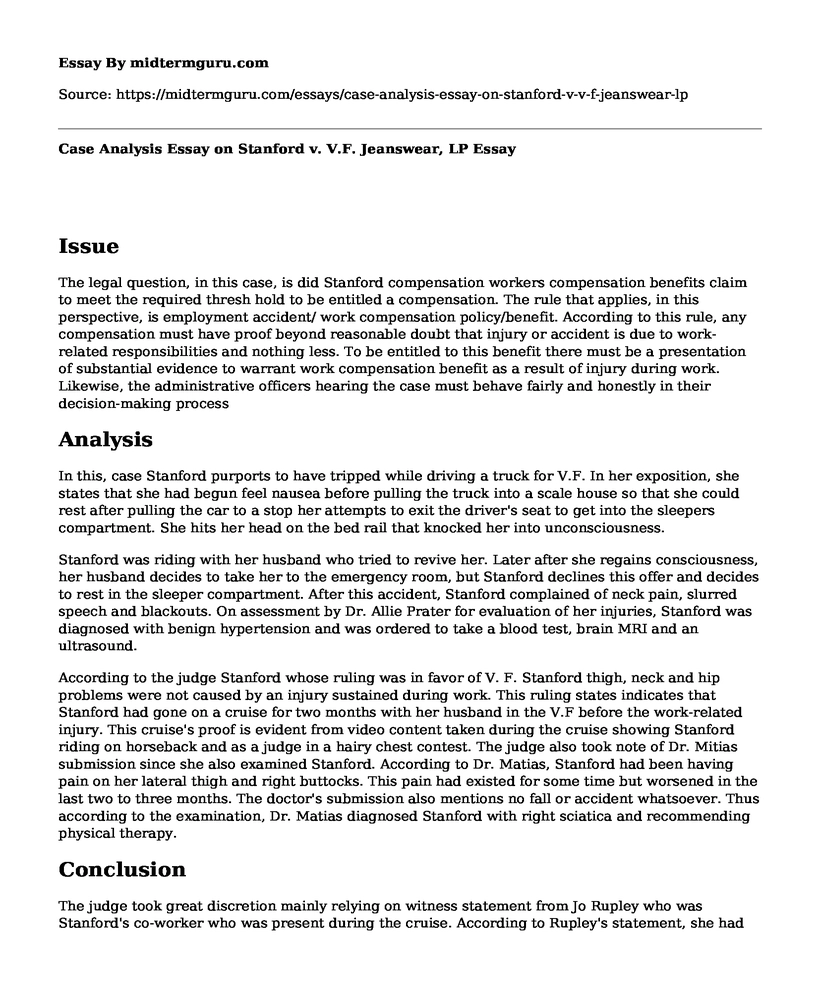Issue
The legal question, in this case, is did Stanford compensation workers compensation benefits claim to meet the required thresh hold to be entitled a compensation. The rule that applies, in this perspective, is employment accident/ work compensation policy/benefit. According to this rule, any compensation must have proof beyond reasonable doubt that injury or accident is due to work-related responsibilities and nothing less. To be entitled to this benefit there must be a presentation of substantial evidence to warrant work compensation benefit as a result of injury during work. Likewise, the administrative officers hearing the case must behave fairly and honestly in their decision-making process
Analysis
In this, case Stanford purports to have tripped while driving a truck for V.F. In her exposition, she states that she had begun feel nausea before pulling the truck into a scale house so that she could rest after pulling the car to a stop her attempts to exit the driver's seat to get into the sleepers compartment. She hits her head on the bed rail that knocked her into unconsciousness.
Stanford was riding with her husband who tried to revive her. Later after she regains consciousness, her husband decides to take her to the emergency room, but Stanford declines this offer and decides to rest in the sleeper compartment. After this accident, Stanford complained of neck pain, slurred speech and blackouts. On assessment by Dr. Allie Prater for evaluation of her injuries, Stanford was diagnosed with benign hypertension and was ordered to take a blood test, brain MRI and an ultrasound.
According to the judge Stanford whose ruling was in favor of V. F. Stanford thigh, neck and hip problems were not caused by an injury sustained during work. This ruling states indicates that Stanford had gone on a cruise for two months with her husband in the V.F before the work-related injury. This cruise's proof is evident from video content taken during the cruise showing Stanford riding on horseback and as a judge in a hairy chest contest. The judge also took note of Dr. Mitias submission since she also examined Stanford. According to Dr. Matias, Stanford had been having pain on her lateral thigh and right buttocks. This pain had existed for some time but worsened in the last two to three months. The doctor's submission also mentions no fall or accident whatsoever. Thus according to the examination, Dr. Matias diagnosed Stanford with right sciatica and recommending physical therapy.
Conclusion
The judge took great discretion mainly relying on witness statement from Jo Rupley who was Stanford's co-worker who was present during the cruise. According to Rupley's statement, she had no observation of Stanford having trouble with her neck, back or any other part of the body during the cruise. Stanford also states that she had informed Swinton, Horton, and Rupley of her fall while driving the V.J. This statement is not true, as her colleagues deny ever being informed of the fall accident during presentations before the judge.
References
Stanford v. VF JEANSWEAR, LP, 84 So. 3d 825 (Miss. Ct. App. 2011).Toys" R" Us, Inc. v. FTC, 221 F.3d 928 (7th Cir. 2000).
Cite this page
Case Analysis Essay on Stanford v. V.F. Jeanswear, LP. (2022, Oct 19). Retrieved from https://midtermguru.com/essays/case-analysis-essay-on-stanford-v-v-f-jeanswear-lp
If you are the original author of this essay and no longer wish to have it published on the midtermguru.com website, please click below to request its removal:
- Internet Crimes Categories
- The Role of Institutions Towards Health Promotion and General Human Life in the Society
- Paper Example on Juvenile Delinquency Treatment
- Paper Example on Business Law: E-mails as Contracts
- The Sixth and Seventh Amendments of the Constitution - Paper Example
- US Gun Ownership: High Restrictions, Highest Violence - Essay Sample
- Plato Justices - Essay Sample







